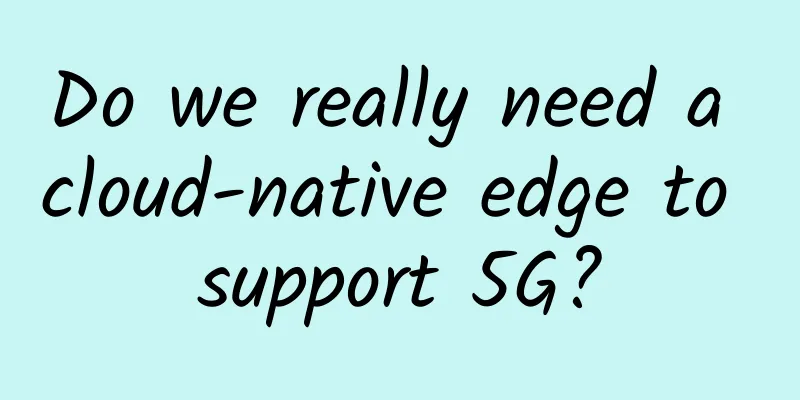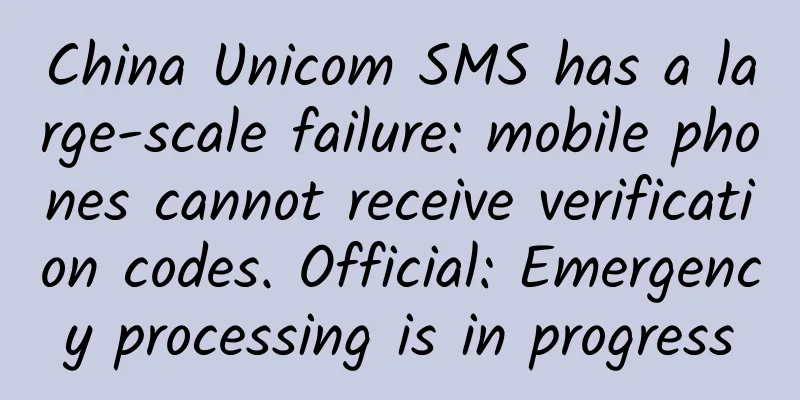Do we really need a cloud-native edge to support 5G?

|
[51CTO.com Quick Translation] Convergence has been a term used in the telecommunications industry for decades, ever since telecommunications vendors transitioned from switch networks to IP-based networks. While the convergence of voice and Internet has indeed enabled people to watch videos on their smartphones, telecom companies have still not achieved the goal of converging telecom and enterprise services.
Trends that disrupt the status quo The pinnacle of modern phone technology is 4G LTE, a set of protocols that has revolutionized mobile phone technology and permeated our daily lives, but for some people, something is missing. 4G LTE technology connects people's phones and tablets, as well as a range of other devices such as home alarm systems. But from a business perspective, telecom companies are only providing communications services, which stay on the smartphone interface. 5G promises to change that, enabling the long-desired convergence between telecommunications and enterprise services. While 5G is indeed the next-generation replacement for 4G LTE that brings amazing performance to people’s mobile devices, it’s much more than that. 5G is actually a family of protocols that operate at different distances. A simple but useful way to think about 5G is that it’s a replacement that combines the capabilities of 4G LTE, Wi-Fi, and Bluetooth. But that’s an oversimplification, mostly because both Wi-Fi and Bluetooth are undergoing their own next-generation transformations, especially since the next generation of Wi-Fi will have a range of tens of miles. However, once 5G is fully rolled out, the diversity of 5G-enabled endpoints will eclipse 4G LTE. Anything from a laptop to an alarm sensor to the price tag on your clothing could potentially become a 5G endpoint. The rise of edge data centers But from an enterprise perspective, the most transformative aspect of 5G isn’t just its impact on the Internet of Things, but the role of “micro” data centers. As part of the ongoing 5G rollout, telecommunications companies are rapidly deploying small data centers around the world, from cell tower sites to community access points to server rooms in office buildings. Industry experts consider these locations to be “near-end” endpoints, as distinct from “far-end” endpoints. Telecom companies are investing in building and deploying a large number of micro data centers, ostensibly because the mid-range 5G protocol (which is considered a next-generation Wi-Fi competitor) requires the deployment of geographically dispersed base stations. But for telecom companies, the biggest success of 5G is not just competing with next-generation Wi-Fi. Their investments are mainly used to build edge computing capabilities for enterprises and web-scale companies. In fact, this 5G-driven expansion is making edge computing a reality. Edge computing brings computing and storage resources closer to the users of those resources, thereby reducing network latency and making computationally and data-intensive tasks (i.e., AI training and inference) more cost-effective, requiring data from far away. For example, if AI technology is used to detect suspicious behavior from hundreds or thousands of videos in large facilities such as factories, power plants or airports, and instead of transmitting this data to the cloud, small data centers close to the edge will play an important role. Running software infrastructure in edge data centers Only software infrastructure running in edge data centers can support workloads like data-intensive AI applications, or any other business application that runs at least partially at the edge. Today, this software infrastructure relies on Kubernetes. Kubernetes brings the massive scale and dynamic capacity required for edge computing. In addition, many edge data centers run Kubernetes on OpenStack, essentially making them full "bare metal" clouds that run primarily on open source software. Much of this software infrastructure is driven not just by its economics, as open source allows organizations to scale the project to meet their diverse and dynamic business needs. In fact, a lightweight version of Kubernetes is coming to market that is ideal for running in edge data centers. However, the term “lightweight” may be a misnomer. While the open source community has crafted OpenStack/Kubernetes-style offerings that are well-suited to the micro-clouds that edge data centers are becoming, there is nothing lightweight about the functionality of this software. In contrast, the open source community is also working hard to scale Kubernetes to unprecedented levels of scalability, with Kubernetes deployments numbering in the millions of clusters. Why do you need to run millions of Kubernetes clusters across the edge? Are millions of Kubernetes clusters running a comparable number of workloads truly suitable for edge data centers? Perhaps, but that’s not the right question. The right question should be, “Can multiple edge data centers and cloud and on-premises environments be abstracted to support millions of Kubernetes clusters in a complex hybrid IT environment?” The “hybrid” environment is a mix of cloud, on-premises, and edge computing. Today, running Kubernetes on top of such a hybrid IT infrastructure is still very difficult, and cloud native computing will effectively support infinitely scalable Kubernetes deployments running across cloud platforms of various sizes and locations. Infinite scaling is great, but given that today’s deployed Kubernetes environments scale to tens of clusters at most, it makes one wonder how millions of clusters will be handled. The market as a whole and the ingenuity of its participants will be the ultimate arbiter of this question. But some plausible scenarios can be hypothesized. Given that 5G-enabled IoT will generate far more raw data than it does today, it’s clear that the AI processing we want to implement should be distributed at the edge. In a mature 5G world, no matter how much bandwidth is expanded, latency will have to be dealt with. Faced with such physical limitations and the surge in data volume, a widely distributed edge cloud environment will enable performance to be continuously optimized. Web-scale applications can also be limited by available infrastructure. People rely on 100 Mbps+ home bandwidth, Wi-Fi, and public cloud infrastructure to deliver top-tier features for products like Netflix, Amazon Prime, etc. 5G and Kubernetes-enabled edge clouds will deliver next-generation services to homes and businesses. The real beneficiaries, however, will be services that people haven’t thought of yet, or that a few visionaries can’t imagine. Today, we can run multiple versions of a new service to gauge customer response. What if we were running millions of versions at once, using sophisticated AI algorithms to decide which versions should scale up and which should scale down? If there is full-blown cloud computing technology running on every cell tower, what does the term “cloud computing” really mean? Should people continue to use the term, or will it lose its meaning? When removing the influence of market hype, cloud computing is basically the abstraction of computing, storage, and network resources. When adopting cloud computing services, people no longer care about how these resources work, but just access them as services. Given the convergence brought about by 5G, “communication” can be added in. Now, cloud computing replaces the original three resources with these four. With the rise of edge computing, you could say that people are running cloud computing at the edge, or maybe you could say that edge computing is part of cloud computing. But the best way to think about it is more broadly from a cloud-native perspective. The essence of cloud-native computing is a comprehensive abstraction across all IT that enables people to apply the characteristics of cloud computing (such as scale-out, elasticity, and flexibility) to hybrid IT environments in a consistent way. So it can be said that traditional cloud + edge cloud + 5G + all endpoints are part of the cloud computing story. It doesn’t matter if everything is still called cloud. Original title: Do We Really Need a 5G-Enabled Cloud-Native Edge? Author: Jason Bloomberg [Translated by 51CTO. Please indicate the original translator and source as 51CTO.com when reprinting on partner sites] |
<<: Let’s talk about 6G communication technology again
>>: The biggest problem with 5G: not the technology, but the lack of “killer applications”
Recommend
Biyouxue: Solve growing pains with software development cloud
Education is an eternal research topic, and its i...
With the advent of 5G, will edge data centers become popular?
The epidemic has interrupted the construction pro...
How to optimize network operations in times of change
As the impact of the coronavirus pandemic has cha...
GSA report: 63 operators around the world have launched commercial 5G services
The latest global 5G network development report f...
PacificRack has run away
The tribe has not shared any information about Pa...
my country has entered the ranks of innovative countries, with remarkable achievements in 5G, artificial intelligence, and autonomous driving
The world trend is surging forward. If we stop th...
Byte side: Can TCP and UDP use the same port number?
Hello, everyone, I am amazing. Today I saw an int...
165 million! China Mobile’s 5G user number announced, is 4G really outdated?
[[377452]] On January 20, China Mobile announced ...
A brief discussion on the application and suggestions of IPv6 in enterprise transformation
As the digital transformation of enterprises cont...
What is DNS? Why are there only 13 DNS root servers? Is it really that difficult to give one to China?
The Domain Name System is one of the most importa...
China Telecom and Huawei establish a joint business innovation center to achieve win-win business through innovative cooperation models
China Telecom and Huawei jointly announced the es...
After talking so much about 5G, the most critical technology is here
When it comes to antennas, everyone must be famil...
[Black Friday] AlphaVPS: AMD Ryzen KVM/Large Hard Drive KVM, starting at 15 Euros per year, Los Angeles/Bulgaria Data Center
AlphaVPS's Black Friday special packages incl...
Don’t let digital experience get in the way of your business strategy
Do you remember the last time you expressed your ...
CloudCone: SC2 promotional annual payment starting at $32.94/year, free snapshot backup, Los Angeles data center
CloudCone offers several special packages for Val...









